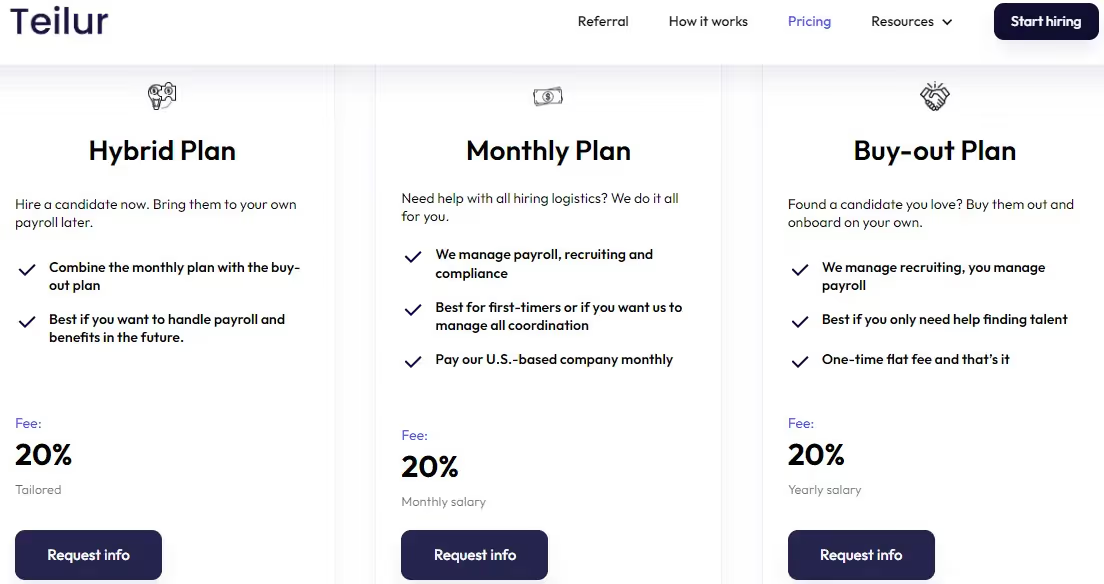Transparent Rate Pricing is emerging as a transformative trend in the remote recruiting sector, particularly within the tech industry. This innovative approach, led by Teilur Talent, an emerging player in the industry, is addressing the longstanding issues of lack of transparency in pricing structures, fostering trust, and ensuring equitable compensation between clients and developers. In this article, we delve deeper into the essence and the two main pillars of Transparent Rate Pricing and its significant impact on the outsourcing and nearshoring industry.
The Dilemma of Hidden Costs
Traditionally, many remote recruiting companies have obscured fees and markups, causing a disconnect between clients and developers. This lack of transparency often results in a disproportionate distribution of payments, with the majority being retained by the recruiting firm, leaving developers feeling exploited and undervalued and clients feeling most of the money is going to a third-party.
The Imperative of Transparent Rate Pricing
TransparentRate Pricing, a concept championed by Teilur Talent, is crucial for building trust and ensuring equitable remuneration in remote recruiting. It is built on two main pillars:
Pillar 1: Transparency Before Interaction
Teilur Talent exemplifies this pillar by disclosing the distribution of payments between the company and the hired talent directly on their website and making a stand that the company will never charge more than 20% of the gross payment of a client.
For instance, if a client pays Teilur Talent $7,000/month for a full-stack Software Engineer, it is clear that at least $5,600 goes directly to the developer, with Teilur Talent retaining a maximum of $1,400. This level of transparency is established before any interaction with a sales representative, ensuring clarity from the outset.

Pillar 2: Clarity in Expected RatesThis pillar is foundational as it ensures that potential clients gain a clear understanding of service rates before any formal engagement or discussion begins. This clarity is crucial to disrupt the prevalent industry practice where companies, after gauging a client’s budget, propose candidates and quote rates that align closely with this amount, often to maximize their margin.
For instance, if a company learns that a client's budget is $10,000, they might propose a candidate and quote a rate close to this budget, even if the prevailing market rate for the talent is significantly lower. This practice often results in the company extracting as much margin as possible, leaving clients in the dark about the true value and cost of the services they are receiving.
Teilur Talent is keen on disrupting this practice by providing expected salaries or ranges directly on their website, allowing clients to know what to expect in terms of costs before any discussion about budgets begins, ensuring transparency and fairness from the outset and avoiding the pitfalls of hidden costs and inflated margins.
Advantages of Transparent Rate Pricing
The introduction of Transparent Rate Pricing in the remote recruiting landscape can significantly benefit both clients and developers. It demystifies the actual cost of hiring a remote developer, allowing clients to make informed decisions and optimize resource allocation, leading to heightened project success and improved ROI.
Developers, under Transparent Rate Pricing, experience a more affirming and rewarding work environment. Feeling valued and fairly remunerated, developers are inclined to commit to their companies long-term, reducing turnover and fostering a more cohesive and productive team.
Transparent Rate Pricing, spearheaded by Teilur Talent, is a revolutionary step towards establishing trust and ensuring fair compensation in the remote recruiting sector. By adhering to the principles of transparency before interaction and clarity in expected rates, we are paving the way for a more equitable and transparent future in the outsourcing and nearshoring industry, promising successful collaborations and robust team dynamics. For more insights and details on Transparent Rate Pricing, visit Teilur Talent’s website.
We’ve put together a table that helps hiring managers navigate through what we believe a client should be paying based on what we encounter in terms of pricing in the Latin American market.
%25206.53.54%2520p.m..avif)
The table above includes all fees, and at Teilur Talent, at least 80% of the payment goes to the candidate. Based on our pricing structure, a Sr. Developer should be around the $80,000/yr mark with at least 80% of that going directly to the developer supporting the client.
Use the calculator below to check prices for the specifications you are looking for.








